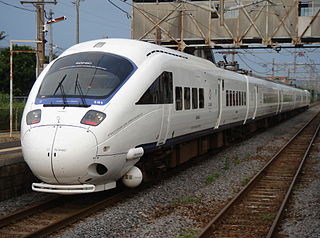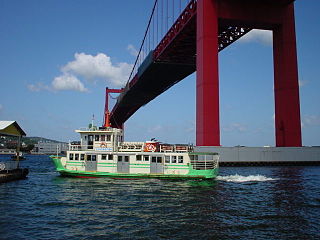Related Research Articles

A diesel multiple unit or DMU is a multiple-unit train powered by on-board diesel engines. A DMU requires no separate locomotive, as the engines are incorporated into one or more of the carriages. Diesel-powered single-unit railcars are also generally classed as DMUs. Diesel-powered units may be further classified by their transmission type: diesel–mechanical DMMU, diesel–hydraulic DHMU, or diesel–electric DEMU.

An electric locomotive is a locomotive powered by electricity from overhead lines, a third rail or on-board energy storage such as a battery or a supercapacitor. Locomotives with on-board fuelled prime movers, such as diesel engines or gas turbines, are classed as diesel-electric or gas turbine-electric and not as electric locomotives, because the electric generator/motor combination serves only as a power transmission system.
An electro-diesel locomotive is a type of locomotive that can be powered either from an electricity supply or by using the onboard diesel engine. For the most part, these locomotives are built to serve regional, niche markets with a very specific purpose.

The Nishitetsu Tenjin Ōmuta Line is a railway line in Fukuoka Prefecture in Kyushu, Japan. It is the main line of the private railway company Nishi-Nippon Railroad (Nishitetsu). The line connects Nishitetsu Fukuoka (Tenjin) Station in Chūō-ku, Fukuoka with Ōmuta Station in Ōmuta. Until 2000, the line was called the Nishitetsu Ōmuta Line.
Railroad electrification in the United States began at the turn of the 20th century and comprised many different systems in many different geographical areas, few of which were connected. Despite this situation, these systems shared a small number of common reasons for electrification.
The Kinki Sharyo Co., Ltd. is a Japanese manufacturer of railroad vehicles based in Osaka. It is an affiliate company of Kintetsu Corporation. In business since 1920 as Tanaka Rolling Stock Works, and renamed The Kinki Sharyo Co., Ltd in 1945, they have produced light rail vehicles used by a number of transportation agencies, especially in the United States. Kinki Sharyo is listed on the Tokyo Stock Exchange as TYO: 7122.

The Kawasaki Railcar Manufacturing Company is the rolling stock manufacturing subsidiary of Kawasaki Heavy Industries. Since beginning operations in 1906, the company has produced more than 90,000 railroad cars.
A hybrid train is a locomotive, railcar or train that uses an onboard rechargeable energy storage system (RESS), placed between the power source and the traction transmission system connected to the wheels. Since most diesel locomotives are diesel-electric, they have all the components of a series hybrid transmission except the storage battery, making this a relatively simple prospect.

The Kūkō Line is a subway line, part of the Fukuoka City Subway system in Fukuoka, Japan. It connects Meinohama, Nishi Ward to Fukuokakūkō, Hakata Ward, all within Fukuoka. The line's color on maps is orange. Officially, the line is called Line 1 . The line has a through service with JR Chikuhi Line. Like other Fukuoka City Subway lines, stations are equipped with automatic platform gates, and trains are automatically operated by ATO system. However, JR train cars are operated manually.

A battery electric multiple unit (BEMU), battery electric railcar or accumulator railcar is an electrically driven multiple unit or railcar whose energy is derived from rechargeable batteries driving the traction motors.

The Hitachi A-train is a family of rail rolling stock built and designed by Hitachi Rail using a common base and construction techniques. The stock is designed to facilitate a number of product life-cycle improvements including ease of manufacture, increased energy efficiency, and recyclability.

The Class DF50 (DF50形) is a class of Bo-Bo-Bo wheel arrangement diesel-electric locomotives operated by Japanese National Railways (JNR) in Japan from 1957 until 1983.

Transport in Fukuoka-Kitakyushu is similar to that of other large cities in Japan, but with a high degree of private transport. The region is a hub of international ferry services and has a high degree of air connectivity and a considerable rail transport network, complemented with highways and surface streets. It includes public and private rail and highway networks; airports for international, domestic, and general aviation; buses; motorcycle delivery services, walking, bicycling, and commercial shipping. The foci of the public transport system are Hakata Station, Tenjin Station, and Kokura Station, in Fukuoka and Kitakyushu cities respectively. Between these two cities lies a more sparse weblike regional rail network.

The Nishitetsu Amagi Line is a Japanese railway line operated by the private railway operator Nishi-Nippon Railroad (Nishitetsu), which connects Kurume and Asakura in Fukuoka Prefecture.

The Salt Lake, Garfield & Western Railway, nicknamed through most of its history as The Saltair Route, is a short line railroad located in Salt Lake City, Utah. Originally incorporated as a dual passenger and freight railroad, it now provides freight-only railcar switching services to industries in Salt Lake City along its sixteen miles of track.

The Southern California Railway Museum, formerly known as the Orange Empire Railway Museum, is a railroad museum in Perris, California, United States. It was founded in 1956 at Griffith Park in Los Angeles before moving to the former Pinacate Station as the "Orange Empire Trolley Museum" in 1958. It was renamed "Orange Empire Railway Museum" in 1975 after merging with a museum then known as the California Southern Railroad Museum, and adopted its current name in 2019. The museum also operates a heritage railroad on the museum grounds.
References
- ↑ Jones, Robert C. (1993). Two Feet to the Lakes. Pacific Fast Mail. p. 221. ISBN 0-915713-26-8.
- ↑ Ferneyhough, Frank (1975). The History of Railways in Britain. Reading: Osprey. ISBN 0-85045-060-8.
- ↑ "Railroad History Timeline: 1920-1929". RRHX: Michigan's Internet Railroad History Museum. Archived from the original on 27 February 2009. Retrieved March 12, 2009.
- ↑ ja:羽越本線#歴史#全通以降 (Japanese language) Retrieved January 13, 2016.
- ↑ "History of Mass Transit in Williamsport". Williamsport Bureau of Transportation. 2005. Archived from the original on 2005-08-08. Retrieved 7 August 2005.
- ↑ it:Stazione di Ostia Antica#Storia
- ↑ "Head on at Deschenes". Colin Churcher's Railway Pages. Archived from the original on 2006-09-28. Retrieved October 23, 2006.
- ↑ "Test Diesel Locomotive Shch". Relics of Science & Technology Database. Polytechnical Museum. 2004. Retrieved January 12, 2010.
- ↑ "Hitachi Metals Ltd". Fundinguniverse. Retrieved January 15, 2010.
- ↑ Marshall, John (2003). Biographical Dictionary of Railway Engineers (2nd ed.). Oxford: Railway and Canal Historical Society. ISBN 0-901461-22-9.
- Michiganrailroads.com, Railroad history timeline - 1920s Archived 2006-07-16 at the Wayback Machine . Retrieved June 28, 2005.